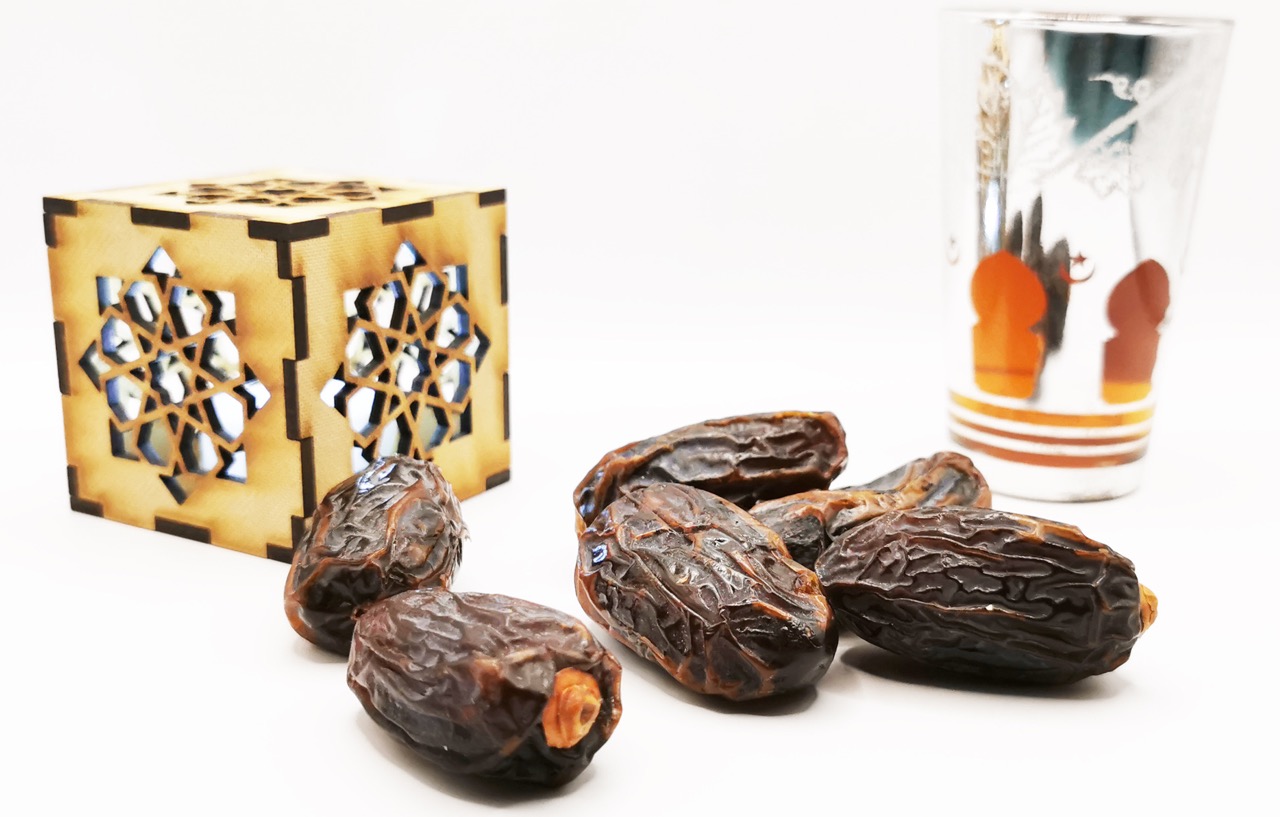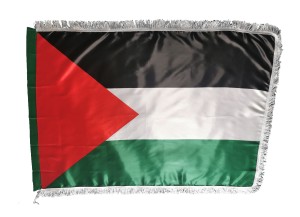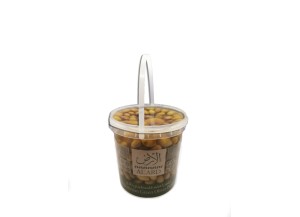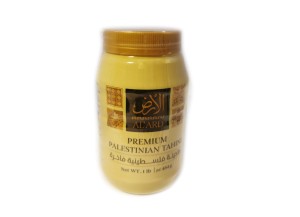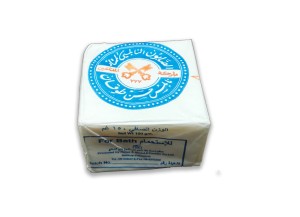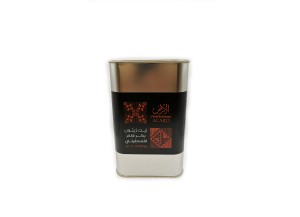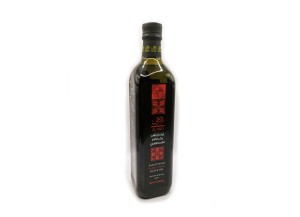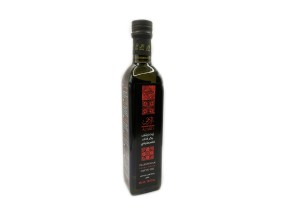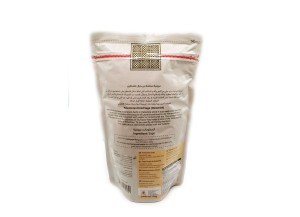Maftoul (Couscous) 450g, Made in Palestine
Maftoul (Couscous) 450g, Made in Palestine
Maftoul (Couscous) 450g, Made in Palestine
Ingredients: Maftoul (Couscous)
Weight: 450g
Storage: Conserve in a dried place.
Maftoul (Couscous) 450 g. Made in Palestine.
What is Maftoul (Palestinian Couscous)?
Maftoul is a traditional Palestinian couscous dish made from bulgur wheat. It is a staple food within Levantine and Palestinian cuisine.
The name maftoul comes from the Arabic word "fa-ta-la" meaning "to roll or wrap." It refers to the process of rolling and shaping the coarse grains of bulgur wheat into small balls that resemble couscous.
Maftoul has a long history within the region. Bulgur wheat has been cultivated in the Levant since ancient times. The technique of steaming the wheat and rolling it into pellets likely originated a few centuries ago.
Maftoul emerged as a distinct Palestinian cuisine component during the Ottoman era. It became firmly established as a beloved national dish in the 20th century.
The main difference between maftoul and regular couscous is the base ingredient. Maftoul uses coarse bulgur wheat while regular couscous uses semolina flour.
Maftoul grains are much larger in size compared to the fine granules of traditional North African couscous. It has a pleasantly chewy texture and ability to absorb flavors.
Maftoul is considered the Palestinian take on couscous, with its own distinct cultural heritage and culinary traditions built around it. It holds a special place in the hearts of Palestinians as a taste of home.
Ingredients Needed for Maftoul
Maftoul is made from just a few simple ingredients that can likely be found in most well-stocked pantries.
The core ingredients for basic maftoul are:
• Maftoul couscous - This is the giant pearl couscous that gives the dish its name. It looks similar to regular couscous but is much larger.
• Chicken broth - This provides moisture and flavor. Vegetable broth can be substituted for vegetarian/vegan maftoul.
• Onions - Finely diced or grated onions add aroma.
• Olive oil - A drizzle of olive oil brings richness.
• Spices - Common spices are cumin, coriander, paprika, cinnamon, and turmeric.
• Salt and pepper - Season to taste.
• Parsley or cilantro - Chopped fresh herbs for garnish.
Additional ingredients can be added for more complex maftoul recipes:
• Chicken, beef, lamb, or seafood - Cooked meat adds protein.
• Vegetables - Tomatoes, carrots, zucchini and eggplant are popular choices.
• Nuts - Toasted pine nuts, almonds or pistachios add crunch.
• Dried fruits - Raisins, cranberries or apricots lend sweetness.
If you don't have certain ingredients on hand, possible substitutions include:
• Broth - Use water mixed with bouillon cubes or powder.
• Onions - Shallots, leeks, or garlic can be used instead.
• Spices - Experiment with spices you have available.
• Herbs - Use any fresh green herbs like dill, basil, or mint.
With just a few simple ingredients, you can make flavorful maftoul dishes to enjoy this Palestinian staple couscous.
Step-by-Step Instructions for Cooking Maftoul
Cooking maftoul is easy once you know the steps. Here is a simple recipe and instructions for making perfect maftoul at home:
Ingredients:
• 2 cups maftoul (giant couscous)
• 4 cups water or broth
• 1 tsp salt
• 2 tbsp olive oil
Instructions:
1. Rinse the maftoul under cold running water to remove any dust or debris. Drain well.
2. In a medium pot, bring the water or broth to a boil over high heat. Add the salt.
3. Once boiling, add the maftoul slowly, stirring continuously with a wooden spoon. This prevents the grains from sticking together.
4. Cook for 10-12 minutes, stirring frequently, until al dente. Maftoul should be chewy but not mushy.
5. Drain the maftoul well in a colander and rinse with cold water to stop the cooking process.
6. In a large bowl, drizzle the olive oil over the maftoul and mix well so each grain is evenly coated. This prevents sticking and adds flavor.
7. Your basic maftoul is now ready to eat! For added flavor, you can mix in sauteed onions, sautéed meat, roasted vegetables, herbs, spices, nuts, dried fruits, etc. Get creative!
8. Serve the maftoul warm or at room temperature. Maftoul makes excellent leftovers too. Simply reheat with a splash of water or broth to restore moisture and texture.
And that's it! With these simple steps you can enjoy perfect maftoul couscous in your own kitchen. Adjust cooking time if you prefer your maftoul more al dente or soft. Play with mix-ins and accompaniments until you find your favorite maftoul recipe.
Storing and Freezing Maftoul
Maftoul is versatile and keeps well, making it easy to prep a batch for multiple meals. Here's how to store maftoul:
Storing Uncooked Maftoul
• Store dry, uncooked maftoul in an airtight container in a cool, dry place like the pantry.
• Kept this way, maftoul can last for several months.
• For maximum freshness and flavor, try to use within 3-4 months of purchasing.
• Transferring to an airtight jar or resealable plastic bag helps prevent bugs or moisture.
Refrigerating and Reheating Leftovers
• Cooked maftoul leftovers can be refrigerated for 3-5 days.
• Store in an airtight container and ensure maftoul is cooled completely before refrigerating.
• To reheat, add a few tablespoons of water or broth and warm in a saucepan over medium heat.
• Stir frequently until heated through. You can also reheat in the microwave.
Freezing Cooked Maftoul
• Maftoul freezes well for long-term storage.
• Portion into freezer bags or airtight containers, leaving 1⁄2 inch of headspace.
• Freeze for up to 3 months.
• Thaw overnight in the fridge before reheating.
• Add extra broth or water when reheating to compensate for any moisture lost.
Maftoul Cooking Tips from the Experts
Maftoul is a staple in many Palestinian kitchens, and experienced home cooks have gathered wisdom over the years on how to make it just right. Here are some pro tips from grandmas and chefs for cooking perfect maftoul every time:
Start with High-Quality Ingredients
The starting point for great maftoul is using fresh, high-quality ingredients. Opt for whole wheat maftoul over refined for better texture and nutrition. Make sure to rinse the grains thoroughly before cooking. Use real chicken or vegetable stock, not bouillon cubes.
Get the Ratio Right
Maftoul expands as it cooks, so the ratio of maftoul to liquid is crucial. A general rule of thumb is 1 cup of dry maftoul to 3 cups of liquid. But adjust as needed based on absorption. Don't drown the maftoul, but ensure even cooking.
Browning Onions Adds Depth
Sautéing onions, garlic, and spices in olive oil before adding liquid extracts maximum flavor. Browning the onions caramelizes their natural sugars. This simple extra step makes a big difference.
Partially Cook Ahead
For weeknight meals, you can partially cook the maftoul ahead on weekends. Then just add extra stock when reheating to reach the desired consistency. This handy tip cuts down active cooking time.
Finish with Butter and Salt
Stir in a knob of butter and a sprinkling of salt right before serving. This gives the maftoul a rich, velvety texture. The butter coats each grain and enhances flavor.
Garnish with Nuts and Herbs
Chopped parsley, mint, or cilantro add freshness. Toasted pine nuts, almonds, or pistachios provide crunch. Lemon wedges add brightness. Feel free to get creative with garnishes!
Allow Maftoul to Rest
After cooking, let the maftoul sit covered for 5 minutes off heat. This allows it to fully hydrate and fluff up. Fluff with a fork just before serving for light, separated grains.
With these expert tips, you'll be able to make perfect maftoul worthy of any Palestinian grandmother! Adjust and experiment to find what works for your taste.
Frequently Asked Questions about Maftoul
What exactly is maftoul?
Maftoul is a type of Palestinian couscous made from bulgur wheat. It's similar to regular couscous but the grains are larger, about the size of peppercorns. Maftoul has a pleasantly chewy texture and nutty, earthy flavor.
How is maftoul different from regular couscous?
The main difference is the size of the grains. Maftoul grains are much larger compared to fine, sand-like grains of regular couscous. Maftoul also takes longer to cook, absorbs flavors more, and has a heartier, toothsome texture.
Can I substitute regular couscous for maftoul in recipes?
It's best not to substitute couscous for maftoul in traditional Palestinian recipes, as the texture and flavor profile will be quite different. However, you can experiment to create your own fusion dishes with regular couscous.
What are some common ingredients used in maftoul recipes?
Traditional maftoul recipes use onion, garlic, chicken broth, olive oil, spices like cumin and cinnamon, as well as herbs like parsley. Vegetables like carrots, zucchini and chickpeas are common additions. Lamb, beef or chicken can be used too.
How do I achieve the perfect maftoul texture?
Getting the right balance of water and broth is key. Make sure to stir the pot frequently and taste test the maftoul as it cooks to ensure the grains have absorbed the liquid and are properly tender.
Can I make substitutions if I don't have certain ingredients?
You can substitute vegetable broth for chicken broth. Onions and garlic can be omitted if needed. Spices like cumin can be replaced with others like coriander or curry powder. Herbs like cilantro or dill work instead of parsley.
What are some maftoul recipe variations I can try?
Some options are maftoul with lamb and prunes, butternut squash maftoul, maftoul with chickpeas and za'atar, seafood maftoul, and even dessert maftoul puddings with rose water and nuts.
Nutritional Value and Benefits of Maftoul
Maftoul is a nutritious staple in Palestinian cuisine. Here's a breakdown of its nutritional value and the health benefits it provides:
• High in carbohydrates - Maftoul is made from durum wheat semolina so it contains a good amount of complex carbohydrates to provide long-lasting energy. A 1 cup serving contains around 70g of carbs.
• Rich in protein - With about 12g of protein per cup, maftoul offers more protein than regular couscous. This makes it great for vegetarian and vegan diets.
• Excellent source of fiber - Maftoul contains 5g of dietary fiber per serving, keeping you full and aiding digestion. The whole wheat provides insoluble fiber while semolina has some soluble fiber.
• Provides B vitamins - Maftoul is a good source of B vitamins like niacin, riboflavin, and thiamine which are essential for metabolism and cellular function.
• Low in fat - With only 1g of fat per cup, maftoul is a very low-fat food option. This makes it useful in low-fat diets.
• Gluten-free options available - For those with gluten intolerance, maftoul made from gluten-free grains like rice and corn can be found.
• Versatile ingredient - Maftoul can be incorporated into a balanced diet with vegetables, proteins etc. Its neutral taste complements many ingredients.
• Benefits over couscous - Compared to regular couscous, maftoul has more protein, fewer carbs, and a lower glycemic index. Its larger grains give more texture.
So maftoul provides an array of nutrients and makes for a healthier alternative to regular couscous or pasta in many dishes. Its wholesome nutritional profile makes it a valuable part of Palestinian cuisine.
The Cultural Significance of Maftoul
Maftoul holds a special place in Palestinian food culture and traditions. It is far more than just a staple grain - maftoul is intertwined with Palestinian identity and heritage.
Maftoul is considered the national dish of Palestine. It is served at all major celebrations and events. Wedding feasts, holiday gatherings, and iftar meals during Ramadan all feature maftoul as the centerpiece. The aromas of onions, chickpeas and chicken mingling with maftoul bring back nostalgic memories for Palestinians worldwide.
Beyond special occasions, maftoul is also a regular part of everyday home cooking. Families take pride in their unique maftoul recipes, passed down from generation to generation. Mothers lovingly prepare it for their children in the age-old tradition.
The communal nature of maftoul brings Palestinian families and communities together. Eating from the same large platter bonds people over shared culture and identity.
Maftoul is also symbolic of Palestinian hospitality. Honored guests are always welcomed with a generous spread of maftoul. Refusing second helpings of maftoul is considered impolite.
While maftoul is quintessentially Palestinian, it is also part of the larger Levantine food culture. Similar giant couscous varieties are found across the Mediterranean and Middle East. However, Palestinian maftoul stands out due to its heartier texture, distinct spices, and versatile pairing with many ingredients. It represents the best of Palestinian cuisine for the global palate.
Dishes to Serve with Maftoul
Maftoul is extremely versatile and pairs well with many dishes in Palestinian cuisine. Here are some recommended side dishes, mains, and full meal ideas:
Classic Sides for Maftoul
• Baba ghanoush - The smoky eggplant dip is a perfect complement to maftoul. The creaminess balances the texture of the grains.
• Mutabal - Another eggplant dip, similar to baba ghanoush but with more yogurt. Provides a cooling contrast.
• Tzatziki - The yogurt and cucumber dip adds moisture and brightness.
• Tabouleh - A parsley and tomato salad that adds freshness. The lemon and herbs cut the richness.
• Fattoush - A mix of greens, vegetables and crispy pita chips. Adds crunch.
• Olives and pickled vegetables - Briny, salty flavors that offset the neutral maftoul.
Main Dishes for Maftoul
• Kofta - Spiced meatballs have an affinity for absorbing flavors. The maftoul makes a hearty base.
• Shawarma - Chicken or lamb shawarma meat pairs nicely when served over maftoul.
• Grilled chicken - Simple preparations allow the maftoul to shine.
• Kibbeh - Bulgur and lamb patties or torpedoes complement the couscous.
• Mahshi - Vegetables stuffed with rice or meat served with maftoul on the side.
Sample Meals with Maftoul
• Maftoul topped with spiced lamb, pine nuts, and fried onions. Served with fattoush salad.
• Herb roasted chicken served atop lemony maftoul. Alongside tabouleh and baba ghanoush.
• Maftoul cooked with caramelized onions and chickpeas. Served with spinach fatayer pastries.
• Kibbeh and pickled turnips served over maftoul. With a Greek yogurt sauce.
• Maftoul with roasted vegetables and halloumi cheese. Served with olives and fresh mint.
Your pack shipment
Packages are generally dispatched after receipt of payment and are shipped via SWISSPOST with tracking and drop-off without signature. If you prefer delivery by SWISSPOST Extra with required signature, an additional cost will be applied, so please contact us before choosing this method. Whichever shipment choice you make, we will provide you with a link to track your package online.
Shipping fees include handling and packing fees as well as postage costs. Handling fees are fixed, whereas transport fees vary according to total weight of the shipment. We advise you to group your items in one order. We cannot group two distinct orders placed separately, and shipping fees will apply to each of them. Your package will be dispatched at your own risk, but special care is taken to protect fragile objects.
Boxes are amply sized and your items are well-protected.









